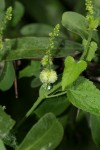4416.000 Tragia
Description of the genus
Erect or scrambling or twining, monoecious (rarely dioecious) perennial herbs or shrubs, with stinging hairs. Leaves alternate, stipulate, often cordate. Flowers in racemes, usually mostly male with 1-2 females at the base. Bracts conspicuous, persistent. Petals 0. Male flowers with 3 sepals and 3 stamens. Female flowers with 3 or 6 pinnate or palmate sepals, becoming enlarged in fruit. Ovary 3-locular. Derivation of name: named after the German botanist Hieronymus Bock, whose Latin name was Tragus, 1498-1554. Worldwide: 100 species in tropical and warm areas Botswana: 4 taxa. Insects associated with this genus:
|
 |
Links to taxa: View: living plant images - herbarium specimen images - all images for this genus
| Species | FZ divisions | Content |
| benthamii Baker | SW | |
| dioica Sond. | N,SW,SE | |
| gardneri Prain | N | Description, Image |
| okanyua Pax | N,SE | Description, Image |
Other sources of information about Tragia:
Our websites:
Flora of Burundi: TragiaFlora of Caprivi: Tragia
Flora of Malawi: Tragia
Flora of Mozambique: Tragia
Flora of Rwanda: Tragia
Flora of Zambia: Tragia
Flora of Zimbabwe: Tragia
External websites:
African Plants: A Photo Guide (Senckenberg): TragiaBHL (Biodiversity Heritage Library): Tragia
EOL (Encyclopedia of Life): Tragia
GBIF (Global Biodiversity Information Facility): Tragia
Google: Web - Images - Scholar
iNaturalist: Tragia
IPNI (International Plant Names Index): Tragia
JSTOR Plant Science: Tragia
Mansfeld World Database of Agricultural and Horticultural Crops: Tragia
Plants of the World Online: Tragia
Tropicos: Tragia
Wikipedia: Tragia